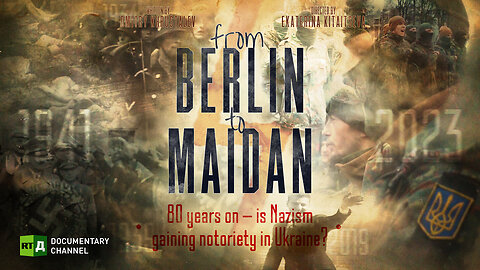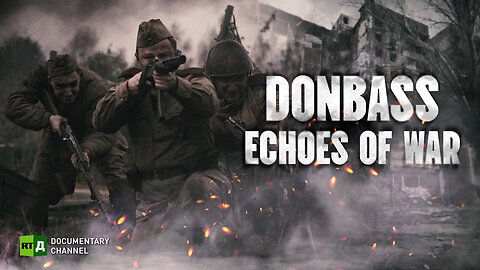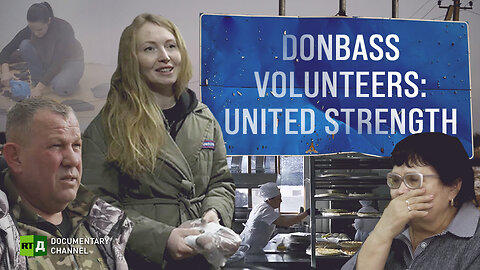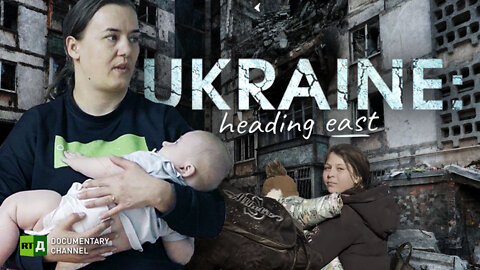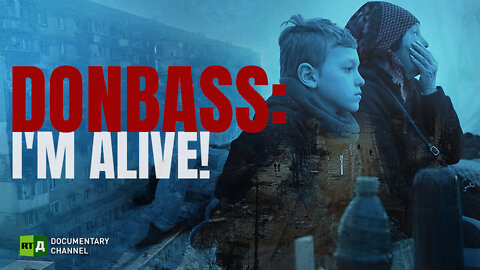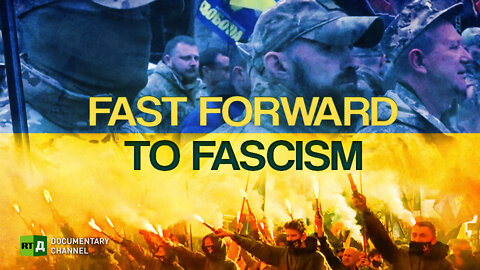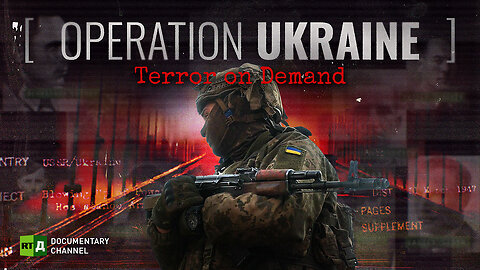
-
Operation Ukraine: Terror on Demand | RT Documentary
 RT DocumentaryIn August 2022, Russian journalist Daria Dugina was killed in a car bomb attack organised by the Ukrainian authorities. Philosopher Aleksandr Dugin, Daria’s father, says she was targeted because she was 'a symbol of the independence of Russian journalism.’ Two months later, an explosion rocked the Crimean Bridge that links the Crimean peninsula to Russia’s mainland. The massive blast was attributed to Ukrainian sabotage groups. According to official figures, Russian security services regularly foil dozens of subversive acts. The documentary takes a close look at methods used by Ukraine’s Security Service, tracing their roots back to the 1940s. It also sheds light on ties between Ukrainian nationalist leaders and American intelligence agencies. Declassified documents revealed details of the US’s Operation Aerodynamic, which funded and directed Ukrainian nationalists' fight against the Soviet Union. In the documentary, historians draw parallels between nationalists past and present.4.72K views 3 comments
RT DocumentaryIn August 2022, Russian journalist Daria Dugina was killed in a car bomb attack organised by the Ukrainian authorities. Philosopher Aleksandr Dugin, Daria’s father, says she was targeted because she was 'a symbol of the independence of Russian journalism.’ Two months later, an explosion rocked the Crimean Bridge that links the Crimean peninsula to Russia’s mainland. The massive blast was attributed to Ukrainian sabotage groups. According to official figures, Russian security services regularly foil dozens of subversive acts. The documentary takes a close look at methods used by Ukraine’s Security Service, tracing their roots back to the 1940s. It also sheds light on ties between Ukrainian nationalist leaders and American intelligence agencies. Declassified documents revealed details of the US’s Operation Aerodynamic, which funded and directed Ukrainian nationalists' fight against the Soviet Union. In the documentary, historians draw parallels between nationalists past and present.4.72K views 3 comments -
From Berlin to Maidan | RT Documentary
 RT DocumentaryIn 1945 the Soviet Union defeated Nazi Germany and put an end to the Nazis atrocities at the cost of 27 million lives of the Soviet people. Now 80 years later, the same nationalist ideas the Soviet people had been fighting against is starting to spread across Ukraine. History books in Ukraine are being rewritten, with nationalist leaders Stepan Bandera and Roman Shukhevich being made new role models, while the monuments of WWII heroes are being demolished as in the case of General Nikolay Vatutin. The First Ukrainian Front liberated Kiev in November 1943 under his command. Tragically, the General was fatally wounded in the crossfire with the Ukrainian nationalists and he eventually died at the hospital. The monument erected in his honor in 1948, was taken down by the nationalists descendants. As scholars flip through the history of Nazism during WWII, they find more and more resemblance to what is currently happening in Ukraine. For instance, the Munich Pact of 1938 signed by Germany, Italy, Great Britain, and France required Czechoslovakia to surrender its border regions and defenses (the so-called Sudetenland) to Nazi Germany. By signing this, European countries tried to protect themselves from the imminent German expansion. Almost the same thing happened in 2014 with the Minsk Agreements signed by Russia, Ukraine and the Organization for Security and Co-operation in Europe (OSCE), with France and Germany at the helm, as they sought to end the civil war in Donbass but the agreements were never fully implemented and the hostilities never stopped. Watch the documentary to find out if the Nazism is really making a comeback in Ukraine and will history repeat itself?3.14K views 2 comments
RT DocumentaryIn 1945 the Soviet Union defeated Nazi Germany and put an end to the Nazis atrocities at the cost of 27 million lives of the Soviet people. Now 80 years later, the same nationalist ideas the Soviet people had been fighting against is starting to spread across Ukraine. History books in Ukraine are being rewritten, with nationalist leaders Stepan Bandera and Roman Shukhevich being made new role models, while the monuments of WWII heroes are being demolished as in the case of General Nikolay Vatutin. The First Ukrainian Front liberated Kiev in November 1943 under his command. Tragically, the General was fatally wounded in the crossfire with the Ukrainian nationalists and he eventually died at the hospital. The monument erected in his honor in 1948, was taken down by the nationalists descendants. As scholars flip through the history of Nazism during WWII, they find more and more resemblance to what is currently happening in Ukraine. For instance, the Munich Pact of 1938 signed by Germany, Italy, Great Britain, and France required Czechoslovakia to surrender its border regions and defenses (the so-called Sudetenland) to Nazi Germany. By signing this, European countries tried to protect themselves from the imminent German expansion. Almost the same thing happened in 2014 with the Minsk Agreements signed by Russia, Ukraine and the Organization for Security and Co-operation in Europe (OSCE), with France and Germany at the helm, as they sought to end the civil war in Donbass but the agreements were never fully implemented and the hostilities never stopped. Watch the documentary to find out if the Nazism is really making a comeback in Ukraine and will history repeat itself?3.14K views 2 comments -
Donbass: Echoes of War | RT Documentary
 RT DocumentaryThe history of Donbass is deeply linked to World War II; the intense battles fought there and the heroism shown by the people continue to shape the region's identity and resilience to this day. The spring of 2014 in Mariupol is recognized as a pivotal moment in the ongoing conflict in Donbass. It marked the first time since 1945 that local residents heard gunfire echoing through their streets.1.74K views
RT DocumentaryThe history of Donbass is deeply linked to World War II; the intense battles fought there and the heroism shown by the people continue to shape the region's identity and resilience to this day. The spring of 2014 in Mariupol is recognized as a pivotal moment in the ongoing conflict in Donbass. It marked the first time since 1945 that local residents heard gunfire echoing through their streets.1.74K views -
Donbass Volunteers: United Strength | RT Documentary
 RT DocumentaryAlexander Zaytsev makes portable stoves and brings them to the fighters in Donbass. He knows firsthand about how precarious conditions are for the fighters in the combat zone. Alexander recognizes that it is the little ordinary things, as well as the attention from people, that soldiers long for the most. The documentary captures the stories of passionate volunteers all across Russia. From crafting stretchers and sewing warm clothes, writing touching poems and establishing charity restaurants, volunteers make a difference in the soldiers everyday routine.1.66K views 4 comments
RT DocumentaryAlexander Zaytsev makes portable stoves and brings them to the fighters in Donbass. He knows firsthand about how precarious conditions are for the fighters in the combat zone. Alexander recognizes that it is the little ordinary things, as well as the attention from people, that soldiers long for the most. The documentary captures the stories of passionate volunteers all across Russia. From crafting stretchers and sewing warm clothes, writing touching poems and establishing charity restaurants, volunteers make a difference in the soldiers everyday routine.1.66K views 4 comments -
Donbass War: Summer 2014. Retracing the steps | RT Documentary
 RT DocumentaryIn 2014, the conflicts and contradictions that have existed for decades between Ukraine’s agrarian west and industrial east turned into civil strife and then into war. The differences in mentality, language, and traditions were too irreconcilable. As a result, the Euromaidan movement, which began as a struggle for Ukraine’s integration into the European Union, rapidly veered towards outright nationalist ideas. Radical groups started to play a leading role in Maidan. The regime change, which occurred due to Maidan, was seen in south-eastern Ukraine as a coup d'état. All the more so because the forces that won in Kiev immediately outlined a new vector for the country’s development. One of the first decisions by Ukraine’s parliament was to cancel the special status of the Russian language. Thousands joined the protests in the south-eastern regions. As a result, Donetsk and Lugansk regions proclaimed themselves the People’s Republics. Essentially, the protesters were replicating Maidan tactics. But what was acceptable for protesters in Kiev and the west, was unforgivable for the people of south-eastern Ukraine. So the new authorities responded with force. In the spring of 2014, the ATO, an anti-terrorist operation, was announced.3.48K views 4 comments
RT DocumentaryIn 2014, the conflicts and contradictions that have existed for decades between Ukraine’s agrarian west and industrial east turned into civil strife and then into war. The differences in mentality, language, and traditions were too irreconcilable. As a result, the Euromaidan movement, which began as a struggle for Ukraine’s integration into the European Union, rapidly veered towards outright nationalist ideas. Radical groups started to play a leading role in Maidan. The regime change, which occurred due to Maidan, was seen in south-eastern Ukraine as a coup d'état. All the more so because the forces that won in Kiev immediately outlined a new vector for the country’s development. One of the first decisions by Ukraine’s parliament was to cancel the special status of the Russian language. Thousands joined the protests in the south-eastern regions. As a result, Donetsk and Lugansk regions proclaimed themselves the People’s Republics. Essentially, the protesters were replicating Maidan tactics. But what was acceptable for protesters in Kiev and the west, was unforgivable for the people of south-eastern Ukraine. So the new authorities responded with force. In the spring of 2014, the ATO, an anti-terrorist operation, was announced.3.48K views 4 comments -
Ukraine: Heading East. Donbass residents taking refuge in Russia | RT Documentary
 RT DocumentarySoutheastern Ukraine has been a war zone for the last eight years. Government forces have been shelling their people because of differences concerning language, political affiliations, and their country’s future. Not everyone was happy with this pro-Western sentiment. The southeastern part of Ukraine has always felt closer to Russia. Some of its residents are ethnically Russian or have relatives in Russia. Most Ukrainians speak Russian, and it’s the predominant language in some regions. Attempts to ban it only adds fuel to the fire. Ukraine’s neo-Nazis took advantage of the situation and began to wipe out the Russian-speaking population. Crimea was the first Ukrainian region to express discontent and voted to return to Russia. Later, the people of Donbass also stood up to protect their land. However, the Ukrainian government was unable to cope with the situation. It continually shelled the country’s southeastern part for the next eight years while simultaneously seeking closer integration with the West. In the late February of 2022, Russian forces and volunteers helped Donbass refugees to leave their destroyed homes and have a chance at a new life. Russia took in 2,500,000 people.5.51K views 3 comments
RT DocumentarySoutheastern Ukraine has been a war zone for the last eight years. Government forces have been shelling their people because of differences concerning language, political affiliations, and their country’s future. Not everyone was happy with this pro-Western sentiment. The southeastern part of Ukraine has always felt closer to Russia. Some of its residents are ethnically Russian or have relatives in Russia. Most Ukrainians speak Russian, and it’s the predominant language in some regions. Attempts to ban it only adds fuel to the fire. Ukraine’s neo-Nazis took advantage of the situation and began to wipe out the Russian-speaking population. Crimea was the first Ukrainian region to express discontent and voted to return to Russia. Later, the people of Donbass also stood up to protect their land. However, the Ukrainian government was unable to cope with the situation. It continually shelled the country’s southeastern part for the next eight years while simultaneously seeking closer integration with the West. In the late February of 2022, Russian forces and volunteers helped Donbass refugees to leave their destroyed homes and have a chance at a new life. Russia took in 2,500,000 people.5.51K views 3 comments -
Donbass Under Fire. Life in the Donetsk Republic Under Bombs | RT Documentary
 RT DocumentaryAfter the Donetsk People’s Republic was proclaimed, war ravaged Donbass. Ukrainian artillery has been shelling towns and villages. Some people were lucky to get evacuated. Others stayed at their own peril and lost connection with their families. Either way, they did their best to survive in the ruins of their own houses and hope for a better future. Andrey Lysenko and his son Vladislav are volunteers who drive across the devastated Donbass and distribute humanitarian aid to locals bought with subscribers’ money. Sometimes they travel with projectiles flying and bombs exploding around, but they are used to it. Their main goal is to help the people of Donbass to hold on and have all they need to survive. The locals tell stories about Ukrainian nationalist and armed forces coming into their towns and villages, hiding among the civilian population, with tanks firing in the middle of residential neighbourhoods. DNR residents who were separated from their relatives and loved ones by the front line venture out to the once Ukrainian city of Volnovakha, which now belongs to the DNR, to look for them and possibly reunite. But not everybody is willing to leave the houses they’ve been living in for years and abandon their pets. How do people find the courage to remain strong and compassionate during shelling?1.41M views 3 comments
RT DocumentaryAfter the Donetsk People’s Republic was proclaimed, war ravaged Donbass. Ukrainian artillery has been shelling towns and villages. Some people were lucky to get evacuated. Others stayed at their own peril and lost connection with their families. Either way, they did their best to survive in the ruins of their own houses and hope for a better future. Andrey Lysenko and his son Vladislav are volunteers who drive across the devastated Donbass and distribute humanitarian aid to locals bought with subscribers’ money. Sometimes they travel with projectiles flying and bombs exploding around, but they are used to it. Their main goal is to help the people of Donbass to hold on and have all they need to survive. The locals tell stories about Ukrainian nationalist and armed forces coming into their towns and villages, hiding among the civilian population, with tanks firing in the middle of residential neighbourhoods. DNR residents who were separated from their relatives and loved ones by the front line venture out to the once Ukrainian city of Volnovakha, which now belongs to the DNR, to look for them and possibly reunite. But not everybody is willing to leave the houses they’ve been living in for years and abandon their pets. How do people find the courage to remain strong and compassionate during shelling?1.41M views 3 comments -
Donbass: I'm Alive! Mariupol survivors of Ukrainian attacks find shelter | RT Documentary
 RT Documentary“It’s the Azov battalion. They forced people out of their houses and into basements. Then tanks started shooting from here, from there,” a Mariupol resident shared her story with the film crew. Over 400,000 people in Mariupol had to go underground because they couldn’t leave the city. The film tracks stories of people who had to survive in Mariupol under Ukrainian shelling. Sheltering in cellars and watching Ukrainian tanks firing at residential buildings. They have all gone through hell and back. Now they’re happy to be alive and hope for a new beginning. A Russian military officer drives across shelled Mariupol to distribute humanitarian aid. A volunteer from Texas, who came to Donbass eight years ago, as he refused to believe American propaganda, helps reunite families separated during the evacuation. A hieromonk who was taken hostage by Azov members and tortured miraculously survived and dedicated his life to studying the origins of nazism in Ukraine. A courageous OB-GYN who runs a maternity ward helped give birth to 25 women during the bombing. Hundreds of people who got a chance to be evacuated lost connections with the rest of their families who stayed. With no cell service and internet connection, their only hope was to get a word through Russian soldiers who would find relatives and friends and relay their messages.1.36K views
RT Documentary“It’s the Azov battalion. They forced people out of their houses and into basements. Then tanks started shooting from here, from there,” a Mariupol resident shared her story with the film crew. Over 400,000 people in Mariupol had to go underground because they couldn’t leave the city. The film tracks stories of people who had to survive in Mariupol under Ukrainian shelling. Sheltering in cellars and watching Ukrainian tanks firing at residential buildings. They have all gone through hell and back. Now they’re happy to be alive and hope for a new beginning. A Russian military officer drives across shelled Mariupol to distribute humanitarian aid. A volunteer from Texas, who came to Donbass eight years ago, as he refused to believe American propaganda, helps reunite families separated during the evacuation. A hieromonk who was taken hostage by Azov members and tortured miraculously survived and dedicated his life to studying the origins of nazism in Ukraine. A courageous OB-GYN who runs a maternity ward helped give birth to 25 women during the bombing. Hundreds of people who got a chance to be evacuated lost connections with the rest of their families who stayed. With no cell service and internet connection, their only hope was to get a word through Russian soldiers who would find relatives and friends and relay their messages.1.36K views -
Fast Forward to Fascism. Ukrainian nationalism in the making | RT Documentary
 RT DocumentaryThe nationalist movement in Ukraine didn’t just happen; it took years to build. It's been growing for years, nurtured by western curators and supported by western funds. By the beginning of the Maidan, an entire network of neo-nazi units had already been up and running in Ukraine, but the Ukrainian government didn’t prosecute them. Ready and able military and terrorist units dispersed and showed up at anti-Maidan meetings in Ukraine’s cities. The years 2019 and 2020 saw meetings and protests in Kiev demanding the denial of special status for the DNR and LNR breakaway regions. One of its main goals was to form an ideology that would dehumanise Russians and break all ties that existed for decades before. Initially, Russians weren't seen as a minority in Ukraine, but the anti-Russian sentiment gradually became overwhelming. Nationalists have been taught how to lead a war on social media, eventually launching a guided communication battle against the Russian people. Stepan Bandera was the head of the Ukrainian nationalist organisation in 1929. In 1934, the Gestapo accepted the Berlin chapter of the organisation — he organised terrorist acts, killing officials. In 1941, the Ukrainian nationalist organisation was responsible for the biggest Jewish pogrom in Lvov, killing about 7,000 people. Yet, in 2010, Stepan Bandera was pronounced a national hero, with torch-lit marches in his honour ever since.9.43K views 14 comments
RT DocumentaryThe nationalist movement in Ukraine didn’t just happen; it took years to build. It's been growing for years, nurtured by western curators and supported by western funds. By the beginning of the Maidan, an entire network of neo-nazi units had already been up and running in Ukraine, but the Ukrainian government didn’t prosecute them. Ready and able military and terrorist units dispersed and showed up at anti-Maidan meetings in Ukraine’s cities. The years 2019 and 2020 saw meetings and protests in Kiev demanding the denial of special status for the DNR and LNR breakaway regions. One of its main goals was to form an ideology that would dehumanise Russians and break all ties that existed for decades before. Initially, Russians weren't seen as a minority in Ukraine, but the anti-Russian sentiment gradually became overwhelming. Nationalists have been taught how to lead a war on social media, eventually launching a guided communication battle against the Russian people. Stepan Bandera was the head of the Ukrainian nationalist organisation in 1929. In 1934, the Gestapo accepted the Berlin chapter of the organisation — he organised terrorist acts, killing officials. In 1941, the Ukrainian nationalist organisation was responsible for the biggest Jewish pogrom in Lvov, killing about 7,000 people. Yet, in 2010, Stepan Bandera was pronounced a national hero, with torch-lit marches in his honour ever since.9.43K views 14 comments -
Battle for Mariupol: Azov Attack Survivors Hope for a New Life | RT Documentary
 RT DocumentaryFrom February 2022, Mariupol residents had to hide in basements with no water, food or medicine, as Ukrainian forces failed to plan the mass evacuation of civilians. They are stationed in populated areas and use civilians as human shields. The tactic was not intended to win the battle but to extend the operation. The large civilian presence prevented Russian troops from making an active response. While retreating, Ukrainian soldiers fired on civilian buildings to pin the blame on Russian forces. Russian troops took control of Mariupol in early May 2022. The remaining Ukrainian forces still hold the ‘Azovstal’ plant. Today active combat in the city has ceased. In the film, viewers get to see actual footage of city combat, devastated streets and the real stories of civilians. Today, the people of Mariupol can say they have survived hell. But at what cost?1.98K views 9 comments
RT DocumentaryFrom February 2022, Mariupol residents had to hide in basements with no water, food or medicine, as Ukrainian forces failed to plan the mass evacuation of civilians. They are stationed in populated areas and use civilians as human shields. The tactic was not intended to win the battle but to extend the operation. The large civilian presence prevented Russian troops from making an active response. While retreating, Ukrainian soldiers fired on civilian buildings to pin the blame on Russian forces. Russian troops took control of Mariupol in early May 2022. The remaining Ukrainian forces still hold the ‘Azovstal’ plant. Today active combat in the city has ceased. In the film, viewers get to see actual footage of city combat, devastated streets and the real stories of civilians. Today, the people of Mariupol can say they have survived hell. But at what cost?1.98K views 9 comments
